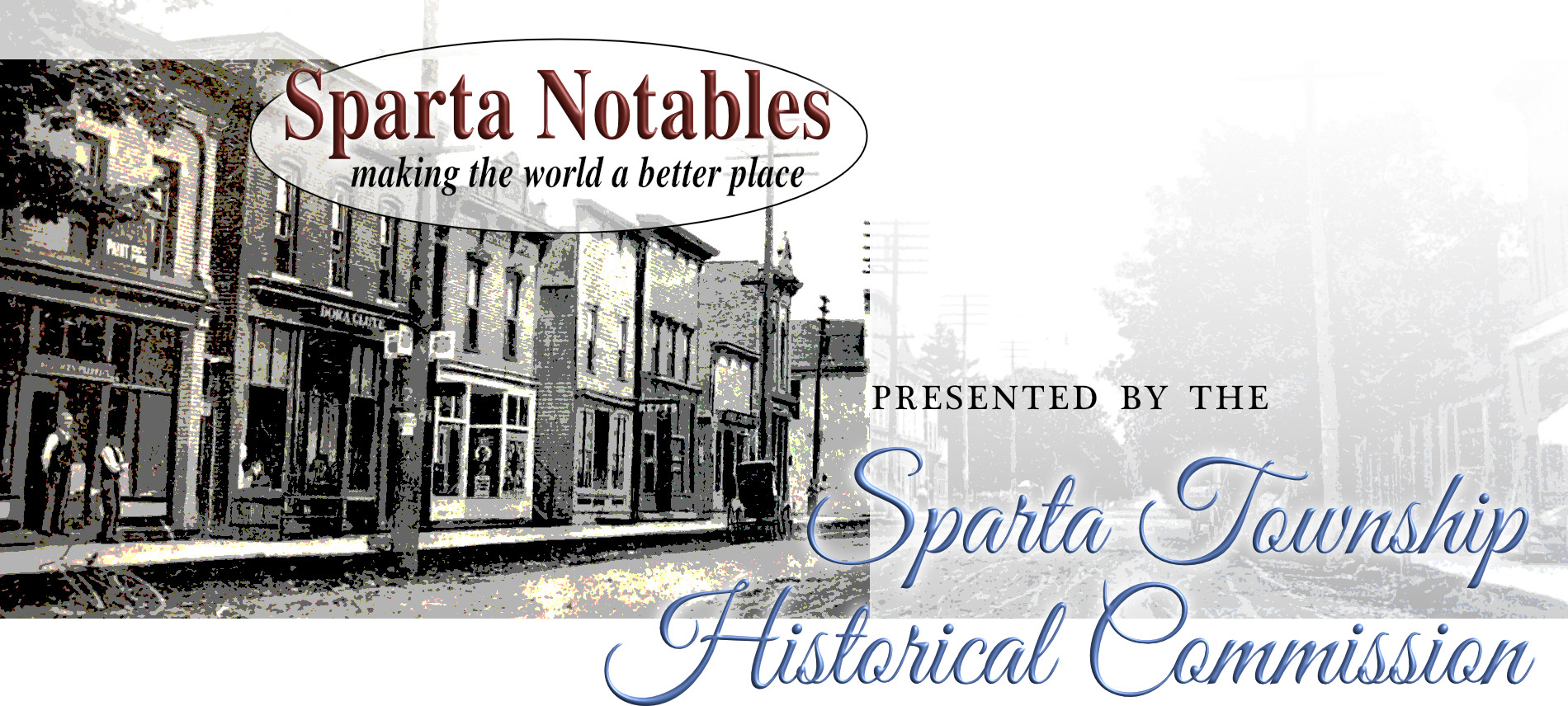

2016
Balyeat | Bradford | Brown | DeLange | Downton | Heath | Keller | Miller | Nieboer | Veterans | Warren
Dr. Gordon Balyeat
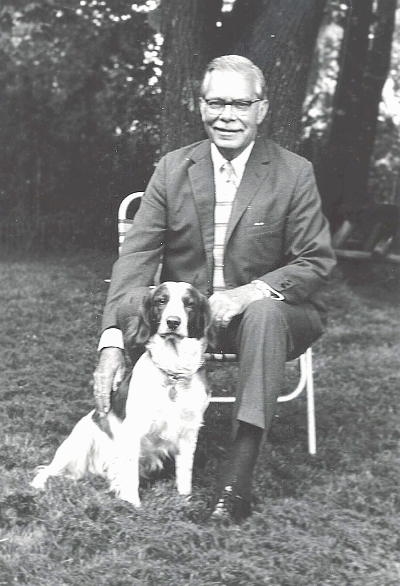
Dr. Gordon Balyeat with his English Springer Spaniel
Balyeat is a name that is known to virtually all Sparta residents. Balyeat Field, located in Spartan Park, was for many years the school’s athletic venue, and, more recently, has served as a community soccer field. The field was named for O. E. Balyeat, the 34-year iconic Sparta Area Schools superintendent from 1909 to 1943. Mr. Balyeat is a 2014 Sparta Notable.
In this first father-son Notable distinction, your Historical Commission is presenting O. E.’s son, Dr. Gordon Balyeat as a 2016 Sparta Notable. Gordon was born in 1911, followed by a younger brother, Phil, in 1915. Born and raised in Sparta, Gordon, in his own words, “…enjoyed a wonderful upbringing in Sparta.” He excelled as a Boy Scout, achieving the first Eagle rank in the state. Graduating from Sparta High School in 1928, Gordon then attended Kalamazoo College and the University of Michigan. At U of M, he was encouraged by an advisor to change the pronunciation of his last name to ‘Bal-yay’, “…because no one will know how to handle B-A-L-Y-E-A-T.” He made the change without looking back, earning an M.D. degree from U of M, then practiced medicine from Seattle to New York.
In 1941, Gordon and Betty Anne Peterson were married. The Balyeats eventually came to Grand Rapids where he practiced internal medicine and served for a time as Chief of Staff at Blodgett Hospital. Dr. Balyeat established the first intensive care unit (ICU) in West Michigan. All told, he was at Blodgett Hospital for over 50 years. Betty’s death in 2008 completed 67 years together.
Gordon served in the Navy (Russell Islands) during WWII where he treated wounded Marines. Professionally, Dr. Balyeat was a Fellow of the American College of Physicians. He was also a member of Kent Country Club, the Peninsular Club, the Audubon Society, and the Izaak Walton League.
As a guest of the Historical Commission, Gordon represented his father at the 2007 opening of Sparta’s new high school, 98 years after O. E.’s introduction to the district. Gordon’s 2009 obituary described him as, “…a person of myriad passions and talents: the trumpet, astronomy, bird watching, fishing, hunting, sports, natural history, and photography, among others.” Dr. Gordon Balyeat died at age 97. He is survived by brother, Phil, a celebrated photographer who lives in Traverse City and is 101 years old.
Donald Bradford
Don and twin brother Duane were born to L D and Lillian Bradford with the assistance of Dr. Thies DeYoung. Without the help of ultrasound, the good doctor exclaimed after Duane was born, “Lil, I think there’s another one in there!” The twins attended kindergarten through twelfth grade at the old school on North Union, walking from their home on Centennial Street.
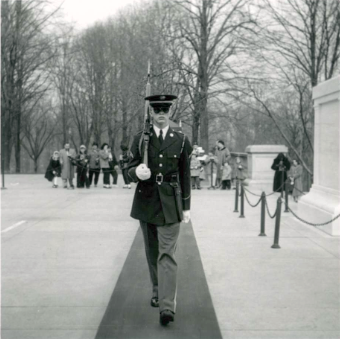
In February 1957, Don Bradford guarding the Tomb of the Unknown Soldier in Washington DC
Always enjoying the leadership role, Don served as president of the class of ‘54 his sophomore through senior years and quarterbacked the ‘53 football team to 9 wins in an undefeated, untied season. His single season record of 16 touchdown passes still stands. He also captained the baseball and basketball teams, setting a new SHS single game scoring record of 31 points in basketball in 1954. The Sparta Athletic Hall of Fame inducted Don in 1998 and his entire football team in 2004.
Entering the Army in 1955, Don was assigned to the 3rd infantry Regiment in Arlington, VA., and was honored to serve as a guard at the “Tomb of the Unknown Soldier” in 1957. After discharge, he joined the Glenn S. Bradford Insurance Agency for a 40 year career and a life of service to the town he loves. A Rotarian also for 40 years, he served as president in 1967 and as chair of the Student Exchange program in a 25 year “labor of love,” touching the lives of hundreds of families and students here and abroad. Don also was co-chair of the hugely successful Sparta Area Quasquicentennial in 1971 which left us with a summer of great memories.
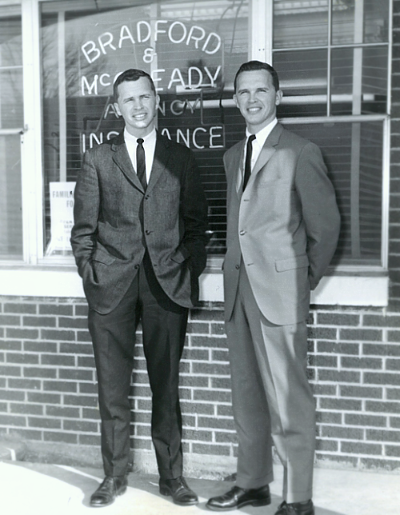
Duane and Don Bradford at their Insurance Agency
In 1984, concerned with the lack of growth in Sparta, Don, along with brother Duane and friend Jim Lyals, started Appletree Development Company with the goal of bringing jobs, new housing options, increased tax base, and retail businesses to Sparta. Because the village was not geared for growth, private money had to be raised through investors and bank loans to create the infrastructure including roads, utilities, a lift station and forced main, plus a costly improvement to the county drain. In spite of many challenges, the original goals were all achieved. Don said, “Choice One Bank had the vision to work with us and the taxpayers passed a bond issue to build the new, much needed water tower on the west side.”
Within the Appletree project, another of Don’s dreams for Sparta was realized as he spearheaded the development of Meadowlark Retirement Home which has served the needs of many area residents over the past 25 years. Don said, “It was one of our original goals. Until then, Sparta residents had to move away when they needed these services.”
Don has been married to his high school sweetheart, Kay Kober, for 57 years. They are charter members of Peace Lutheran Church where Don has served in almost every capacity including president, teacher, elder, choir member, and building committee chair. He has two daughters and two sons and several grandchildren.
Among his hobbies, Don enjoys photography and poetry, winning a local contest with “Hometown Feeling” several years ago - see back page of this booklet.
Aleta Vogel Brown
Aleta Brown was a powerhouse of a woman who brought revolutionary changes to the apple industry in West Michigan and well beyond. Through her market prowess and innovation, she made Jack Brown Produce into a mechanism through which apple growers could market their fruit in large volume to the giant retailers and food chains that were developing in the 50’s and 60’s. As big as her influence was in the male dominated apple industry, it was her personality that inked her reputation as a “legend” in the fruit growing area of West Michigan, where she grew up and which she dearly loved.
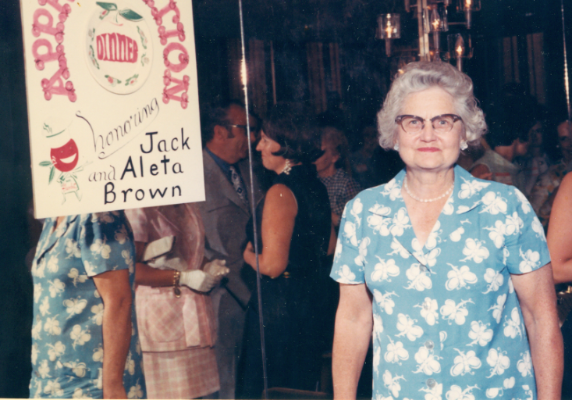
Arleta Brown
Born Aleta Vogel July 10, 1904, on a farm in Alpine Township, she was a lifelong resident of “apple country” until her death on June 27, 1991. After a brief career as a school teacher at Boyd School “Mother/Ma” Brown, (as she became known) and her husband Jarvis “Jack” Brown decided to venture into the wholesale fruit marketing business. Initially they began out of a garage on 2nd Street, then Leonard and Walker in Grand Rapids. They traveled from farm to farm selecting apples, then selling directly to local growers. As the saying goes, “this was the start of something big”.
When Jack decided to retire about 1960, Aleta was still full of ideas, grit, energy and enthusiasm, so she started a grower-owned packing and marketing corporation which she named Jack Brown Produce Inc. They built a state of the art packing facility on Fruit Ridge Avenue just south of 10 Mile Road. This company, following the lead of Belding Fruit, helped change the way fruit was marketed out of West Michigan and deliveries were being made across the state. First to Flint and Detroit and eventually as far away as Winnipeg, Canada.
To many fruit growers, “Ma” Brown was known for her tough approach to running the business and the high standards she set for everything she touched. Local historian Cindy Laug observed, “She was known to be demanding, rough and crusty but did a great job for the Ridge”. John Schaefer Jr., current president of Jack Brown Produce, said “her customers and growers came to have a lot of respect for her. She expected only the best.” Many were awed by Mrs. Brown’s ability to keep track of thousands of boxes and multiple varieties of apples, to know her growers and buyers, to be familiar with her competition, and to keep straight the orders coming in from buyers and brokers in the U.S. and Canada.
In spite of her tough exterior and brusque way of dealing with people, she had a softer side. She loved animals and spending time in her rose garden. She also had a generous heart when it came to causes she really cared about including Meadowlark Retirement Home in Sparta and the Kent County Humane Society.
Dan DeLange

Dan DeLange
Orchestrator Dan DeLange started piano lessons in Sparta with John DeYoung at the age of 7. He became fascinated with the different “colors” of the orchestra and would scribble in his piano music which instrument should play each line of his piano lesson music instead of actually practicing his piano technique! He started on the French Horn in Sparta Middle School, but quickly became curious about all the orchestral instruments. Sparta High School band director, Bob Stiles, gave him a complete fingering chart and encouraged him to take home any instrument he’d like to learn. Laureen Lautzenhuiser, the young band director that followed Mr. Stiles, also recognized his intense curiosity for music, and suggested Dan enter Interlochen Arts Academy for his last year of high school.
After graduating Interlochen, he obtained his BM at Oberlin Conservatory of Music studying bassoon and music composition. Dan continued to practice music arranging while he played and toured with several professional symphony and pit orchestras until he was asked to do orchestrations for Goodspeed Musicals, famous for its reputation in musical theater. That, in turn, led up to him working with many Broadway composers, arrangers, actors, choreographers and directors.
Since then, Dan has orchestrated for The Jim Henson Company (creator of The Muppets), Julie Andrews, Rosie O'Donnell, and Universal Studios. He has scored for songwriters/composers: Paul Williams, Jerry Herman (composer of Hello Dolly, Mame), Harvey Schmitt (composer of The Fantasticks, 110 in the Shade), Charles Strouse (composer of Annie, Bye, Bye Birdie), Peter Link and Mark Hollman (Urinetown) and many top arrangers including David Krane (whose films include Chicago and Into the Woods).
His scores have been heard on Broadway, London’s West End, National & European Tours, and at regional theaters from coast to coast, including over 40 productions at Goodspeed Musicals.
He’d like to warmly thank his hometown of Sparta for encouraging and nurturing his musical adventures.
Please visit Dan DeLange Orchestrations for more information.
Dorothy E. Downton
Dorothy Downton was born Dorothy Elizabeth Hessler to Rev. and Mrs. Edward A. Hessler in Manistee, Michigan, on November 11, 1946.
In 1959 she and her family moved to Conklin when her father accepted a call to Trinity Lutheran Church. After completing eighth grade at Trinity Lutheran School, she was enrolled in Sparta High School in September, 1960, graduating in June, 1964. Following high school, she attended Davenport College of Business (now Davenport University) in Grand Rapids, graduating in December, 1965, with an Associate in Science degree as a Legal Secretary.
Having made application for employment with the Federal Bureau of Investigation (FBI), she was hired and began work in Washington, D.C. on January 17, 1966. Initially assigned to the Prints Division of the Bureau, because of her stenographic skills, she was later transferred to the Washington Field Office of the FBI.
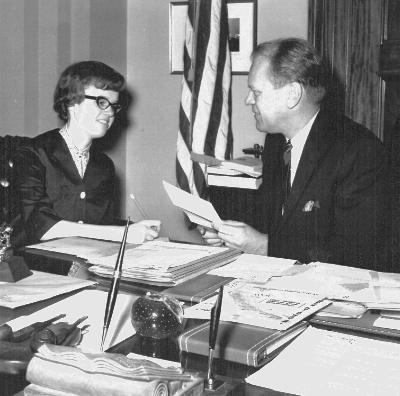
Dorothy Downton working with then Congressman Gerald Ford
Early in her employment with the FBI, she received a job offer from the Office of Congressman Gerald R. Ford. He had recently been elected by his fellow Republican colleagues to be the new Minority Leader of the House of Representatives. As a result of his leadership position, additional staff was needed. She turned down the offer since she had promised to stay with the FBI for at least one year (which was a requirement for new hires). In December, 1966, she received a second offer from Minority Leader Ford's office, because they still needed another secretary who understood shorthand to take dictation. On January 20, 1967, after completing one year and three days with the FBI, she became a secretary to the Administrative Assistant to Minority Leader Ford, Frank Meyer.
From that date until August, 1972, she gained experience, frequently taking dictation from Minority Leader Ford.
Then an event occurred that changed everything. Frank Meyer was in Ford's Grand Rapids office (where he was working on the re-election campaign of Congressman Ford) when he collapsed and died at his desk. Because of the timing, responsibilities were shifted, and Dorothy was selected by Ford to replace his long-time Personal Secretary, Mildred Leonard, as she took on much of the administrative work.
In September, 1973, she met her future husband, David Downton, who was employed on Capitol Hill through the office of Congressman Goodloe E. Byron of Maryland.
Events were moving swiftly as Spiro T. Agnew of Maryland, President Richard Nixon's Vice President, was forced to resign due to irregularities when he was Baltimore County Executive. At the same time, the Watergate scandal was plaguing the Nixon Administration, and Nixon, seeking a candidate for the Office of Vice President who would pass congressional scrutiny, nominated Gerald Ford in October, 1973. Following extensive and probing hearings, including IRS audits, Ford was sworn in as the 40th Vice President of the United States on December 6, 1973, and Dorothy became the Personal Secretary to Vice President Ford, and thus an employee of the United States Senate.
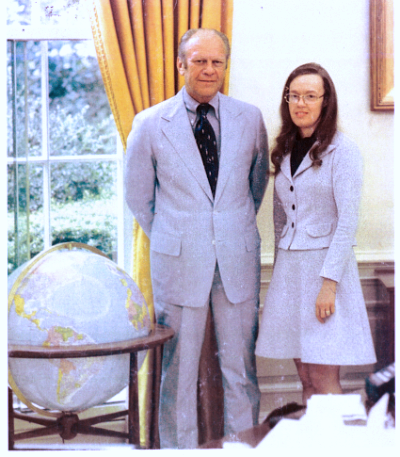
President Gerald Ford and his Personal Secretary, Dorothy Downton in 1975 at the Oval Office
In the aftermath of this turmoil, Dorothy and Dave came to Michigan to be married by her father on December 30, 1973, at Trinity Lutheran Church.
The Watergate scandal very soon became a crisis, and by early August of 1974, it was clear that Richard Nixon would be forced to resign, or face impeachment by the House and trial by the Senate.
On August 9, 1974, Gerald R. Ford became the 38th President of the United States, being sworn in by Chief Justice Warren Burger shortly after noon, when Nixon's resignation took effect. From then until January 20, 1977, Dorothy held the position of Personal Secretary to the President.
After Gerald Ford's electoral loss the previous November, he asked Dorothy and Dave to move with him and Mrs. Ford to Palm Springs, California, where they had decided to reside because of Mrs. Ford's health. Becoming Assistant to the Former President, Dorothy continued to work for former President Ford until November, 1980, when husband Dave's work brought them back to Michigan.
Living in a northern suburb of Detroit, Dorothy, after an eight-year period out of the work force, went back to work outside of the home in May, 1990, as the Personal Secretary for the CEO of Lionel Trains, holding that position until July, 1994.
Finally, in May, 1995, she became the Administrative Assistant to the Chief of Bureau for Michigan of The Associated Press. She retired from The AP on January 18, 2008.
She and husband Dave currently reside in Carleton, Michigan.
Dr. Paul "Pete" Heath
Dr. Paul Richard (Pete) Heath loved all things athletic and academic. Born September 1, 1934, in Sparta, Michigan, to Lowell and Minnie (Larson) Heath, Pete grew up just two blocks north of the school in which he would attend kindergarten through graduation. As a member of the class of 1952, Pete served as class president, quarterbacked Sparta’s football team, and was a member of the varsity basketball and baseball teams. He also sang in the chorus and was a member of the band. Today, Pete Heath’s name can be found in the trophy case at Sparta High School as an inductee to the Sparta Athletic Hall of Fame.
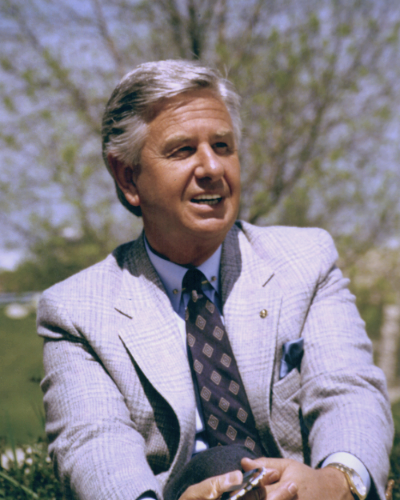
Dr. Paul "Pete" Heath
Upon graduation, Pete enrolled at Western Michigan University, where he quarterbacked the freshman football team that fall. After one academic year at Western with no way to continue to pay for his education, he enlisted in the U.S. Navy with the opportunity to use the GI bill to continue his education. While serving in the medical corps in Jacksonville, Florida, Pete met Mary Jean Kearce, who he would marry in September, 1956. When his enlistment was up, Pete went on to complete his undergraduate work at Central Michigan University. While attending CMU, he received the IIAC Scholarship-Athletic Medal given annually to the Central senior athlete who also excels in the classroom. Upon graduation, Pete would spend a few years teaching and coaching in New Smyrna, Florida, and Howell, Michigan.
Pete began his educational administration career at Kellogg Community College in Battle Creek, Michigan, working in several capacities. He ultimately became Vice President of Instruction in 1973. Pete went on to complete his doctoral degree (Ed.D) in educational leadership at Western Michigan University, at which time he interned in the Michigan State Legislature. From 1973-1974, he served as academic dean at Parkersburg Community College in Parkersburg, West Virginia.
In 1974, Pete was named the founding president of John Wood Community College in Quincy, Illinois. While at John Wood, he was elected chair of the Council of Presidents for the Illinois Community College Association in both 1985 and 1986. In 1987, Pete became the 5th president of Elgin Community College in Elgin, Illinois, where he served until his retirement. He was honored at the White House for his work at Elgin Community College. In 1994, Pete received the Centennial Award from Central Michigan University, an award presented to alumni who have distinguished themselves in their profession. Pete was honored in 2000 as a Transformational Leader by the League for Innovation in community college programs, sponsored by the University of Texas, Austin. In 2006, John Wood Community College chose to name the new community and adult education building in his honor. The Paul Heath Community Education and Fine Arts Center housed John Wood Community College adult education programs as well as a fine arts auditorium.
In his retirement, Pete enjoyed his family and their many accomplishments. He loved to read, listen to gospel music, play golf, and all things University of Michigan football. But before he was Dr. Paul Richard Heath, Ph.D., he was a son and brother; a small town student athlete whose love of athletics was cause for his absence at his brother’s wedding…he was needed as the varsity quarterback in the championship game. Whose love of his high school alma mater was such that he would make the six-hour round trip in a snow storm to watch his great nephew’s varsity basketball game, or arrive early to the baseball game because watching infield practice was as important as all nine innings. Dr. Paul Richard (Pete) Heath…forever a Spartan.
Lou Atkinson Keller
Handy Wacks, one of Sparta’s longest family-owned businesses, is a jewel in the crown of Sparta industry. Organized in 1929, the company found its permanent home in Sparta in 1936. Daniel Atkinson, one of the original stockholders, acquired sole ownership in 1932. Daughter Lou Atkinson Keller joined the company as office manager and assumed ownership of the company along with her siblings, Pearl Atkinson Burtch and Walter Atkinson, when their father died.
Lou Atkinson was born to Daniel W. Atkinson and Emma E. Petter Atkinson on July 12, 1882. She had one brother, Walter, born October 16, 1884, and one sister, Pearl, born on April 16, 1897. Lou was married to James Keller on July 3, 1906, and had three children- Irene Keller (Anderson), Howard Keller, and Audrey Keller (Bear). James and Lou filed for divorce June 1, 1924.
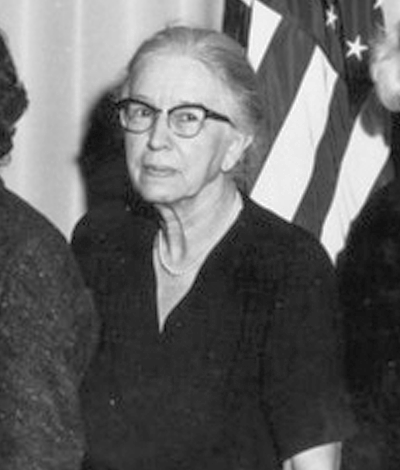
Lou Atkinson Keller
Marcia Anderson Fairchild shares her memories of her grandmother: “Grandma Lou was ahead of her time, a real go getter! I don’t know how many boards she was on,” writes Marcia, “but one was the Kent County Road Commission. She also belonged to the Zonta Club, a business organization working to advance the status of women. She could be 100% business and in the next minute, be 100% Grandma!”
Keller is remembered as one of Sparta’s truly civic-minded people. In June, 1962, her village celebrated Lou Keller Recognition Day, when she was honored as one of Sparta’s outstanding citizens. She was very actively involved in the Methodist Church for many years, the secretary of the Community Foundation, a member of the Ladies Literary Club, and the Sparta Garden Club.
“I think, in our family,” her granddaughter writes, “she was most famous for her baked beans. Her kitchen smelled wonderful. Grandma lived on Harper Drive and I so loved to go down the hill to play in the creek below. Grandma and my mother would sit on top of the hill to watch me.”
“I remember Grandma Lou going to South America,” recalls Marcia. “I have no idea how long she was gone, at least a month and possibly longer. I’m not sure if she went to any other country other than Peru, but she came back with chests and chests of treasures. She always let me go downstairs to go through those “treasures” unsupervised. I could sit there for hours and marvel at all the beauty and also her huge collection of flower vases.”
“She always wore a bun at the nape of her neck,” Marcia writes. “One night we were at her house and she was ready for bed. Her hair was braided in a braid that went all the way down to her waist! Grandma had long hair?”
Marcia has wonderful memories of summers at the lake. “All of Grandma’s children had cottages on a lake in Irons, Michigan. I remember when it was so horribly hot Grandma, Audrey, and my mom would take chairs down and set them in the shallow part of the lake. They would hike their dresses up to their knees and put their feet in the water.”
Lou Keller built on her father’s business and made it her own, quite an accomplishment in those days. Her daughter, Irene, and Irene’s daughter, Marcia Anderson Fairchild, continued to run Handy Wacks along with Marcia’s husband, Hank. Today her sons, Steve and Tim May, Lou’s great grandsons, are still there at 100 E. Averill St. in Sparta….and when you go to a restaurant and your food is wrapped in waxed paper, it’s most likely produced right here in Sparta, by the 5th generation of the family of Lou Atkinson Keller.
Lou Keller passed away on February 24, 1971, but she left her mark on our village. Many remember the tiny woman with the bun at the nape of her neck always moving about town with purpose. She was loved then and remembered now. We were blessed to have her.
Paul C. Miller
Paul Christus Miller was born on December 5, 1901, in an old farmhouse on Baumhoff Road, near Ballard’s Corners. His father, a farmer, was Charles (Tim) Miller, his mother Margaret Brink Miller. They had three children, Lilly, Leonard, and Paul was the youngest of the three.
On December 5, Paul’s third birthday, his father was hunting, and climbing over a wooden fence, the gun he was carrying went off accidently and shot him in the leg and stomach. He lived three days and then succumbed to his wounds. Paul often said he remembered his mother taking him in her arms to the room where his father lay dying, to say goodbye.
Margaret made sure her children all went to school at Ballard’s Corners and records from the school show that all three children had perfect attendance. There were no snow days then. When Paul graduated from eighth grade, four young women made up the rest of the class, and he was the shortest of the five. This was the beginning and ending of his school education.
It is hard to imagine, that this shrimpy little schoolboy, standing on the steps of Ballard’s School, grew to be 6’ 4” tall. That was a good thing. He had an ambition that was unstoppable, and an extreme dedication to honesty, truth, duty, and most of all, a rigid work ethic. In later years, he expected all his employees and his family to live by these very same “rules.” I guess the best way to describe him is that he never expected more of others than he was willing to do himself. Unfortunately, not all of the aforementioned people had the same strength, either physical or emotional, and when we failed him, he would be quite upset, and in loud tones mentioned it to us. He was very much self-disciplined and we tried very hard to be the same, and if we couldn’t discipline ourselves, he certainly encouraged it.
On July 25, 1924, the following happened and I have direct quotes from him. “We was sittin’ on the porch after supper and Ma was shelling peas. We’d been threshing all day and was both bone tired. All of a sudden, Ma sez, ’Get me a pail, I’m going to be sick.’ I run to get the pail, but by the time I got back, Ma was already hunched over and unconscious, and it was a couple of days after that that she died… she never did come to again. The doctor said it was a stroke, and just think, she was only 48 years old.”
After his mother’s death, Mrs. Martin, the lady across the road, prepared meals for him and packed lunches as well. He related that his peanut butter sandwiches were always frozen by lunch time, but he was thankful to have them. Many years later, he paid off the amount owing on the Martin’s home for them. He wanted to let the Martins know how much he appreciated the meals and the frozen sandwiches. Another father-daughter conversation:
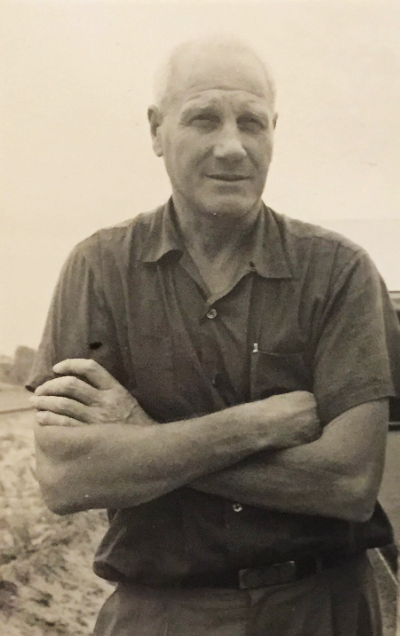
Paul Miller
“When I was runnin’ the farm, I had two mules, I called them Nip and Tuck. Sometimes after I plowed the field, I’d walk along the furrows and pick up arrowheads.“
“Were there many?” I asked.
He said, “Oh yes, there was lots of ‘em.”
“What Indian tribe lived there?” I asked.
“Ojibwas… most everybody called them Chippewas, but their real name was Ojibwas. You know it was a funny thing, I had a big box of them arrowheads. I just wonder where they ever got to.”
Once, while plowing he heard a plane fly over, and he was intrigued and determined that one day he would fly in an airplane. And as always, what he decided he wanted to do, he did! Before my parents were married, Dad was operating his peach and dairy farm, but somehow started thinking that he could build roads. One day as he was driving, he was studying the shoulder, and had a head-on collision. The driver of the other car, a 27-year-old man, was killed.
My father was arrested and taken to jail, (referred to in newspaper accounts as ‘the criminal’) and then, at trial, was given three years or a $3,000 fine (I am not sure about these numbers, but this did happen). My father hadn’t the money to pay the fine to keep him from going to prison, but a number of people in Sparta pooled their money and paid the fine.
My father was absolutely astounded and immensely grateful that his town would do this for him. Several years later, he repaid every penny, but he never forgot what Sparta did for him and that is why he included the town money from the Grand Rapids Foundation in his and my mother’s names every year. Additionally, since he had so little education, he realized the importance of it and one Sparta student receives a scholarship to Grand Valley State University every year.
After Dad started getting into road building, he put sticks of dynamite into the trunk of his car. He had heard that dynamite is more powerful if it is not frozen, so he put a small kerosene heater in with the dynamite for a few minutes… and do I really need to tell the end of this story? There was virtually nothing left but a picture of my mother, one side of it burned. Dad would laugh each time he told this.
After they were married, money was still pretty tight, so he joined the WPA digging trenches for utility pipes… through the frozen ground. I remember that it was always dark, and they would bundle me up and Dad would drive Mother and me to Grandma’s house for the day while he worked. We always had to leave very early in the morning, because the first men there got the work, and my dad was first in line every single day.
A story my dad told, “1929 was a terrible year, the country went into a depression, and on March 28, my barn burned with my cattle in it, and you were born.” I never knew if this was supposed to be funny or not, but he always smiled when he said it. My grandmother said, that on that day, my father came bounding up their stairs whistling as though nothing wrong had happened and announced, “We have a girl!”
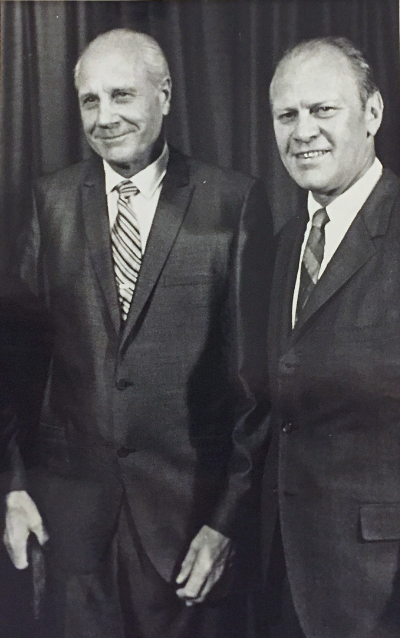
Paul Miller with Gerald Ford
My parents had a very happy marriage, unusual for sure, but joyful. Once Dad started doing jobs further away from home, Mother never knew if he would be home for supper at six, or Thursday. He would just appear, and he would tell us stories about things he saw or did. He was very curious about everything. It was always so nice when he came home, it was almost celebratory. One time, Dad bumped his head on the medicine cabinet, and so he did what any deranged person would do-he ripped it off the wall and threw it on the floor. When I came in, I saw the medicine cabinet on the floor and asked about it. Mother said, “It hit your father on the head, so it is being punished.” That sounded right to me, especially since mother didn’t seem to be distressed in any way. That night Dad came home, and with some tools he reinstalled the medicine cabinet. Never a word passed between my parents about this. It was amazing how they simply accepted whatever happened, that would have, should have, concerned someone, but not them.
After Dad started building roads and airports, we would go where he was working and spend the summer there. One summer we were in Harbor Beach. Mother always took one of Darlene’s friends and one of mine for the summer, wherever we went. My mother was so much fun. While we were there, every other week we would pretend it was someone’s birthday, and Mother would drive us into town where we would buy a little gift. One day while on the way home, we passed Dad’s road job. Inadvertently, Mother managed to drive the whole length of the fresh-rolled asphalt, leaving tire furrows behind her. Men were chasing after the car, waving their arms and yelling for her to stop, but she just kept going, oblivious to the chaos in her wake. Dad never said a word of recrimination. Mother never mentioned it, either.
Dad took us all to the Sunday matinee to see Abbott & Costello Meet Frankenstein on December 7, 1941. When we left the theater, news boys were running around shouting, “We’re at war!” and waving newspapers. I was frightened and I looked at my father and asked, “Will you have to go to war, Daddy?” He just smiled and said, “Don’t worry about it,” but I did worry and so did Mother. He was called to Army headquarters in Michigan, and they wanted to place him with the Seabees. But later, he received a letter stating that with his background building airports, he would be more useful stateside. So he built part of Willow Run Airport in Detroit and the airport at Grayling, MI, and hired contractors to build barracks there.
By that time, I was about fourteen years old and my prayers, birthday wishes, and wishbones finally paid off and I got the baby brother for whom I had yearned for so long, and my father received the son he had always wanted.
Two years later, our family was devastated by the leaving of my father for another woman who ensnared him in her trap. Why not? He was very handsome, flew his own plane, owned his own business, and was wealthy. Just the sort of man a gold digger would chase. After their divorce, he would call my mother infrequently, and ask to have one or another of his children for an afternoon outing. For years after, we had very little contact with our father, but he continued to build highways and roads for the State of Michigan. He frequently flew political and business friends wherever they wanted to go.
As he grew older and recognized his own mortality, he stated that he would like to be cremated. We buried some of his ashes between the graves of his mother and father, most of them next to Mother’s grave, and then Russ carried some in his car waiting for the new runway at Sparta Airport to be built. With its completion, he scattered the remaining ashes of our father in it. Russ made the remark, “I spent more time with my father’s ashes than I ever got to spend with him.”
Edith May Nieboer
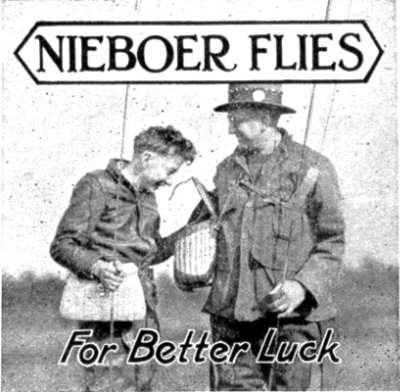
Edith May Nieboer
When noted fishing tackle historian Doug Bucha of Niles, Michigan, became intrigued with the defunct “Nieboer Fly Company,” his research led him to the surprising discovery that the successful fishing tackle manufacturing company had been owned by a woman: Edith Nieboer of Sparta. Edith was born in Englishville, three miles south of Sparta, on September 23, 1905, to Edwin and May (Williams) Mutchler. She attended Sparta Area Schools and on August 26, 1924, married James Nieboer, a rural mail carrier who, in the early 1920s, moved to Sparta where he rented a room from grocer Hubert "Hugh" Finch. Jim, along with Hugh, and Jim’s brother Harry, were avid fishermen, and their enthusiasm for the sport piqued Edith’s interest in tying flies.
In 1928, at age 23, she created The Nieboer Fly Company which was housed in a sizable converted chicken coop on the approximately 80-acre property the couple owned on the north end of Sparta. There it remained until 1938, when Edith moved to Hess Lake to continue her work until her death on May 1, 1974. Harry was her traveling salesman. In the early years, Edith’s business was a blessing to Sparta and the townspeople she employed. Some worked on the Nieboer property, while others worked from home.
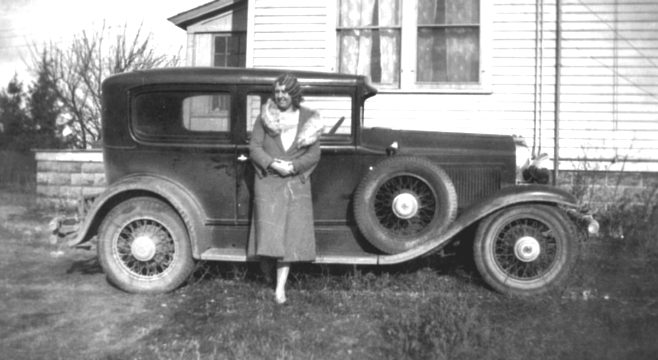
Edith May Nieboer
As Doug Bucha wrote in his article “The Lady With the Golden Hair” (published in a 2003 issue of the National Fishing Lure Collectors Club’s publication The N.F.L.C.C. Gazette), for Edith to have provided employment in her small town “was quite an accomplishment for a lady entrepreneur during the depths of The Great Depression.” Many struggling families were fed thanks to her business acumen. Others, beyond the limits of Sparta, were equally affected. A Pennsylvania tackle shop owner wrote that “thanks to Edith, [he] was able to put five children through college by selling her flies.”
Paw Paw Bait Company eventually purchased Edith’s company, but she continued working with the owners, providing some of the finest hand-tied flies and bass bugs on the market. She herself was a master fly tier and designer. It was Edith who was instrumental in the development of the “Max Sandy” fly (named in honor of the editor of the Grand Rapids Herald’s outdoor page) as well as the renowned “Bob Lincoln” fly. A hardworking, humble, and generous lady, she left behind one daughter, Phyllis Speshock (now deceased); two granddaughters, Janis Clark and Melissa Kleinfeld; and one great-grandson, Eddie Kleinfeld, all of Sparta. She is buried in Englishville Cemetery not far from her childhood home. It was discovered, soon after her death, that she was a direct descendant of Gov. William Bradford of the Mayflower as well as two Revolutionary War soldiers.
The University of Michigan’s Bentley Historical Library houses the Douglas Bucha Collection (2003) of Edith Nieboer advertising materials, photos, and other ephemera.
Civil War Veterans
On April 12, 1861, the Civil War began at Fort Sumter, SC. President Abraham Lincoln called for 75,000 volunteers to enlist with the Union Army. Sparta did its part by sending all eligible men over the age of 18 into service. They left behind their families, homes, and livelihoods to defend the Union. Because of their sacrifice, the Sparta Township Historical Commission is honored to recognize those from the Sparta area that fought in that conflict. The Historical Commission is currently adding to an ongoing roster of every known Sparta man involved in the Civil War. The three men below are but a sample of the stories worthy of remembrance and retelling.
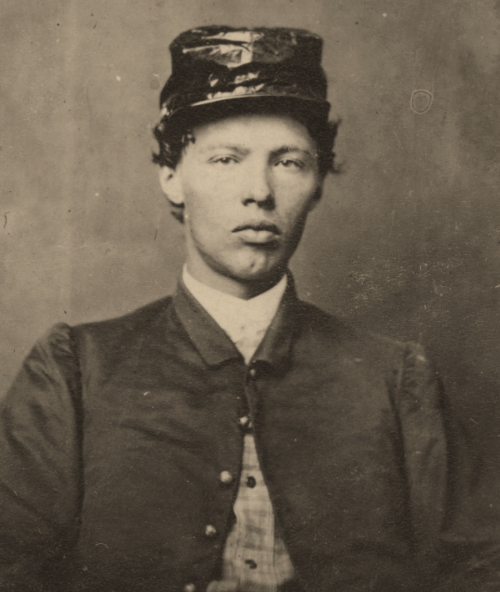
Amherst Cheney
Amherst Cheney was 23 years old when he enlisted in the Michigan Twenty-First Infantry Company B on August 4, 1862, out of Grand Rapids. He served as a quartermaster clerk from April to November of 1863. He was then promoted to quartermaster Sergeant until May 4, 1864, when he was given the rank of Second Lieutenant in Company H on August 2, 1864. On October 29, 1864, he was promoted to First Lieutenant. Cheney was wounded in action on March 19, 1865, at Bentonville, NC, eventually being sent to Washington, DC., until the war’s end. During the war, Amherst wrote very informative and interesting letters to Clementine “Tina” Heath. Those letters are part of the Historical Commission’s permanent collection.
The Michigan Twenty-First was instrumental in the southern campaigns of Tennessee and Georgia. They saw action in the battles of Murfreesboro, Chickamauga, and Chattanooga. Stationed in Chattanooga until June 11, 1864, they built bridges and erected storehouses. At Lookout Mountain until September 20,1864, soldiers built hospitals and ran the sawmill. They were part of General Sherman’s March to the Sea and the Siege of Savannah in December, 1864. Eventually the group moved up the East Coast to Raleigh, NC. There on April 18, 1865, at Bennett Place, they witnessed the surrender of General Joseph E. Johnston and his huge army. The Michigan Twenty-First mustered out at Washington, D. C., June 8, 1865, six days after the end of the war.
Following the Civil War, Amherst Cheney returned to his farm in Sparta. He loved to sing, and established himself as a music and school teacher. In 1869, he married Genie Hinman. Amherst began a successful political career in 1877, serving in the Michigan House of Representatives. He was reelected in 1878, beating out Jonathan Nash, the Democratic candidate. He served as chair of the Harbor Traffic Committee. In 1888, he unsuccessfully ran for governor as the prohibition nominee. In his retirement years, Mr. Cheney became a fruit farmer, also raising bees. Amherst Cheney died on January 9, 1927, and was buried in Greenwood Cemetery. His obituary reports a fondness for retelling his feats in the Civil War to eager listeners.
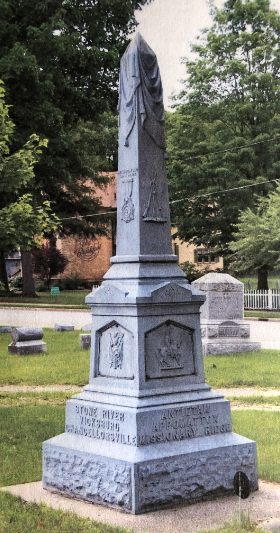
Civil War Veterans Monument at Greenwood Cemetery, Sparta, Michigan
William Vond, at age 43, was the only black man from Sparta who enlisted in the Civil War. He was placed into the Thirteenth United States Colored Artillery Company F as a private on March 15, 1865. He was discharged in Louisville, KY, on November 18, 1865.
The Thirteenth Colored Artillery served garrison duty at Camp Nelson in Nicholasville, KY. Camp Nelson provided the Union Army with over 10,000 African-American soldiers, making it the third largest recruiting and training depot for African Americans in the nation. Many of the black soldiers brought their families with them to Camp Nelson and eventually the army established a refugee camp for these individuals. Thousands of African-Americans came to Camp Nelson and it was here that they gained their freedom.
After the Civil War ended, Vond came back to his farm northwest of Sparta. He died on April 4, 1889, and is buried at Idlewild Cemetery in Kent City.
Pvt. Charles Myers, age 22, enlisted in the Michigan Sixth Calvary Company H. The Sixth was part of The Wolverine Brigade. Along with the First, Fifth, and Seventh Cavalries, this company fought in every major campaign of the Army of the Potomac from the Battle of Gettysburg in July, 1863, to the Confederate surrender at Appomattox Court House in April, 1865.
The Battle of Brandy Station (also called the Battle of Fleetwood Hill) was the largest predominantly cavalry engagement of the American Civil War, as well as the largest ever to take place on American soil. It was fought on June 9, 1863, around Brandy Station, VA, at the beginning of the Gettysburg campaign. The Union Cavalry under Maj. Gen. Alfred Pleasonton was pitted against Maj. Gen. J.E.B. Stuart's Confederate Cavalry.
Private Myers was taken prisoner at Brandy Station and imprisoned at the Camp Sumter Military Prison, Andersonville, GA. Andersonville was one of the largest Confederate military prisons during the Civil War. During the 14 months the prison existed, more than 45,000 Union soldiers were confined here. Of these, almost 13,000 died. Myers succumbed to dysentery at the prison on August 21, 1864. His remains are buried at the Andersonville National Cemetery, Macon, GA.
Approximately 134 men that served in the Civil War were from Sparta and the surrounding area. The ones that returned vowed to never forget. After the war, the Grand Army of the Republic Sparta Post 243 erected a white bronze obelisk monument front and center in Greenwood Cemetery. The inscription reads, “In memory of the heroes who fell in defense of the flag and are buried in unknown graves.”
James Warren
James Arthur “Jimmy” Warren was one of the “brightest and best” to ever graduate from Sparta High School. Certainly his future was a promising one. As a leader and student athlete, he excelled in everything he tried, from becoming an Eagle Scout as a young man to becoming the first pilot to make an enemy kill with the vaunted Navy Hellcat fighter. In the Naval commendation when he was awarded the Distinguished Flying Cross, he was credited with “outstanding skill and heroism.” It was said of him, “At every opportunity Ens. Warren dealt the enemy damaging blows, demonstrating tireless attention to duty and superb courage, in keeping with the highest traditions of the U. S. Naval Service.”
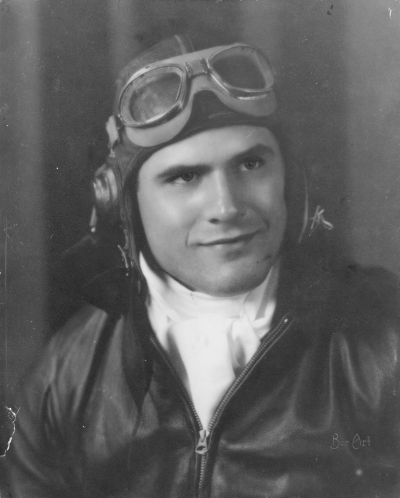
James Warren
Jimmy's life was summarized by his sister-in-law when the James Warren Athletic Award was established. Jim was a running back and Captain of the Sparta High School football team. In 1938, Jim lead his team to the Co-Championship of the Ken-O-Wa League. After graduation in 1939, Jim went on to play football at Grand Rapids Junior College and eventually played at Michigan State.
While Jimmy was in college, the Japanese attacked Pearl Harbor and the United States was brought into World War II. He wanted to join the war effort and decided to put his college career on hold. Determined to serve as a Navy fighter pilot, Jimmy prepared himself by taking flying lessons in Grand Rapids and advanced lessons in Lansing.
Jim enlisted in the Navy in 1942 and took his basic training in New Orleans. He had to study hard and his dedication paid off when he was accepted to the Pensacola Naval Academy in Florida. At the Academy, he trained on aircraft carriers as fighter pilot. After graduation, Jim was assigned to a Navy fleet fighting the Japanese in the South Pacific.
Identified as an outstanding pilot and flying several successful missions, Jim was credited with destroying the first Japanese Zero in the new Grumman Hellcat fighter which was specifically designed to fight in the South Pacific. He was considered “fearless” in battle, which, for a fighter pilot, was considered “....the best quality a man can have.” (as written by Jim's friend, Lt. Jake Rankin).
In 1943, Jim wrote to his parents about the intense fighting with the Japanese over their stronghold on Rabaul. He described the horrors of war and how he was “....flying all day and being bombed all night.” Just days before Christmas, Jim was flying as a section leader in escort to a group of bomber planes when his wingman had engine trouble and was forced to turn back. While Jim was flying alone, the bomber group was attacked by a large force of enemy planes. He turned his sights to the onrushing flock of at least 50 Japanese Zeros and put up an aggressive fight before his plane was shot down. Jim was wounded, but survived the attack. He parachuted into the ocean. Enemy planes wouldn't leave him alone, so Jim had to abandon his life raft and swim toward the shore of a nearby island.
Island natives kept Jim safe for a while, but eventually the enemy discovered his location and placed him in a prisoner of war camp. Conditions were intolerable. The lack of food and medicine ultimately claimed Jim's life. One of the few survivors later met with Jim's father, Charley Warren. He told first hand of Jim's heroic service and ultimate sacrifice. The only thing he was able to bring back from the prison camp was Jim's graduation ring from the Naval Academy which he gave to Charley.
In 1960, the James Warren Athletic Award was established at the request of Jim's football teammate, Dean Bradford, to honor his lost friend. Each year since then, the James Warren Athletic Award had been bestowed to Sparta High School's most outstanding male athlete. Jim would be very proud of each recipient.
Contact
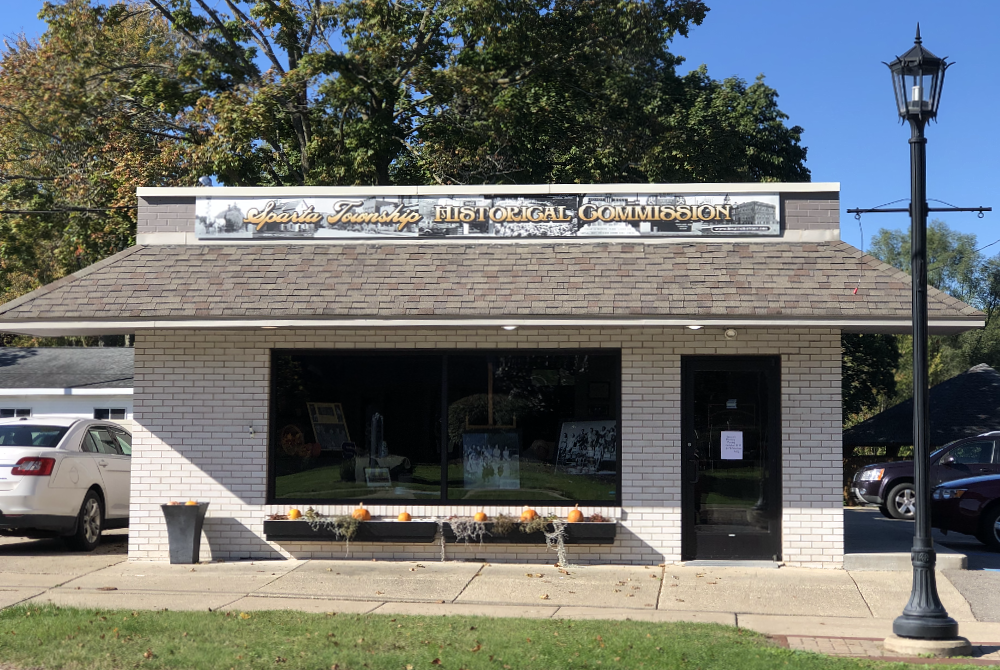
Sparta Township Historical Commission headquarters at 71 North Union Street
Our History Center is conveniently located at 71 North Union Street in downtown Sparta. Please join us for coffee and lively conversation on Monday mornings. Visits to the History Center can also be scheduled by appointment, for your convenience.
We do not receive mail at the History Center, instead, please use our mailing address, which is:
attn: Sparta Township Historical Commission
Sparta Township
160 E. Division St.
Sparta MI 49345.
Our complete archives are now available online for your convenience. Just click STHC PastPerfect Catalog Access and begin your research!
For other inquiries, the Sparta Township Historical Commission can be reached by phone at: (616)606-0765 or via email at the following address:
